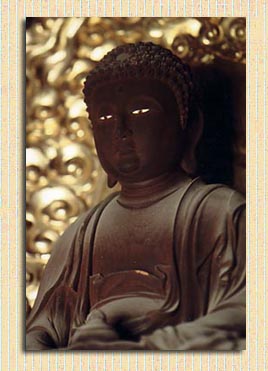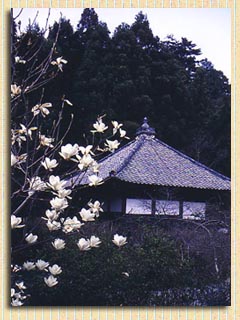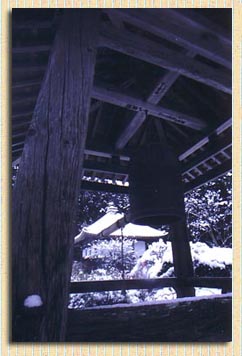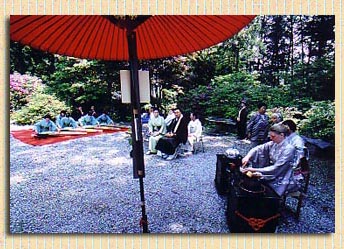| Hello from Daijiji |
Welcome to the Daijiji website. If you’re interested in
Japanese culture, Buddhism and temples, and Buddhist art, please drop by. |
| Daijiji |
Daijiji is formally known as Onodera-san Tenpou-rin-in Daijiji and was built by the priest Gyouki Bosatsu (668-749) in 737 in what is now Iwafune-machi, Tochigi Prefecture. It is a very large temple built on spacious grounds, and it is said that as many as several thousand monks trained there. It is also famous as the temple where the monk Jikaku Daishi Ennin (793-864) underwent training for six years from 9 to 15 years of age. Ennin later became the fourth Chief Abbot of Daijiji. Furthermore, Daijiji is familiar as having ties with the renowned Heian beauty, Ononokomachi. During its history, it was visited by the eminent priest Ippen Shounin (1239-1289), and was where the father of Onodera Zenji Tarou entered priesthood. In the Tenshou Era (1573-1591), it was destroyed by fire in war. However, the Daishi-doh, which was rebuilt in the Kaei Era (1848-1853), the Sourintou Column, which is one of six in the country, the Yakushi-doh where the Yakushi Nyorai (the Healing Buddha) carved by Gyouki Bosatsu is enshrined, and the inner hall wherein Jikaku Daishi practiced meditation, all retain their original flavour. It is the sacred site where Dengyou Daishi Saichou (767-822) and Jikaku Daishi Ennin nurtured distinguished monks such as An-ne and Tokuen. Now it is the oldest historically proven temple in Tochigi Prefecture, and a specially appointed temple of the Tendai sect. |
| Saichou and Daijiji |
The third Chief Abbot of Daijiji, Kohchi (Ennin's master during his period at Daijiji), had close ties with both Kuhkai (774-835) and Saichou, who established the Shingon sect and the Tendai sect, respectively, in Japan. Also, the second abbot of Daijiji, Douchuh, was a disciple of Ganjin (688-763). Under such circumstances, Kohchi was predisposed to sending Ennin to Enryakuji at Mt. Hiei, which was founded by Saichou. There, he received schooling in the teachings of the Tendai sect. This eventually led to Daijiji becoming a Tendai temple. Saichou and several other Tendai monks came to Shimotsuke and Kouzuke when Ennin was 23. At this time, Saichou performed two rites, kanjou and jukai, at Daijiji and Midonoji in Kouzuke. Among the monks that received these rites were Enchou, Ennin, Tokuen and Kohchi, who thus became Saichou's disciples. Kanjou is an important rite of mikkyo (tantrism), and the above event is said to have marked the start of Tendai mikkyo in Japan. In hopes of realizing "the protection of the nation of Japan through Buddhism", Saichou and his followers copied sutra texts such as the hokkekyou and buried them at the spot over which they built a Sourintou Column. The Tendai sect in Japan was established by Saichou at Enryakuji on Mt. Hiei. Until then, Saichou had begun to lose faith in the priests and temples that thought only of their own ambitions. He cloistered himself at Enryakuji and devoted himself to Buddhist studies and later travelled to T'ang China to learn Tendai teachings. The teachings of the Tendai, Ichijou, stipulated that anybody from any walk of life could attain enlightenment by being devout. This expresses the philosophy that all people, even those of low rank or the poor, could equally be saved. Saichou secured the trust of Emperor Kanmu (737-806), but faced severe opposition from advocates of the preexisting Buddhism. Nevertheless, Saichou persevered, amidst great hardship. After his death, he was bestowed the holy name Dengyou Daishi by the Emperor. |
 |
 |
| Jikaku Daishi Ennin |
The third head of the Tendai sect in Japan, Jikaku Daishi Ennin, travelled to T'ang China as a member of the last Imperial Buddhist envoy. He nurtured the Tendai sect in Japan, and is one of the great figures in whom Japan holds great pride. When Ennin was about 9 years old, he began his studies at Daijiji and eventually went to Mt. Hiei, where he became a disciple of Saichou. At 43 years of age, burning with the desire to complete Tendai mikkyo in Japan, he travelled to T'ang China. His record of his journey, Nittou Guhou Junrei Kouki (The Record of a Pilgrimage to China in Search of the Law) is Japan's first real travel diary, and its value is said to be higher than even Marco Polo's (1254?-1324) Touhou Kenbun Roku (The Travels of Marco Polo). Ennin gave up personal ambition to devote his life to ceaselessly pursuing pure Buddhist ways for the sake of saving the people and keeping alive the flame of Buddhism in Japan. Even 1200 years later, he continues to move us deeply, and his teachings are still carried on. Ennin departed for T'ang China, originally for a short period of learning, with strong hopes of completing Tendai mikkyo, as well as of resolving the Enryakuji Miketsu Sanjuh Jou (thirty unsolved problems among monks at Enryakuji). This "short period" eventually became a great adventure spanning nine years. On crossing to T'ang China, Ennin applied himself to the Buddhist teachings. Unfortunately, the Imperial envoy could not receive permission to go to Mt. Tendai, the source of the Tendai teachings in China. However, Ennin's determination to pursue "the Law" was strong, leading him to eventually part company with the official entourage to continue his travels on his own. Travelling in a foreign land without proper permits was dangerous and full of unimaginable hardships. Yet, Ennin, his two disciples, Yuishou and Yuigyou, and a servant, Yoborono Omaro, were able to reach Mt. Godai, a Buddhist site as sacred as Mt. Tendai. After their pilgrimage to Mt. Godai, the group headed for Chouan, the world's largest city at the time. Their schooling in Chouan, particularly with respect to mikkyo, was highly fruitful, but was, sadly, marred by the death of the disciple Yuigyou at the early age of 32. Ennin's grief at losing his dear disciple, with whom he had undergone such a difficult journey, was great. He faced yet further hardship in the form of "Kaishou no haibutsu", the suppression of Buddhism, by the T'ang Emperor Busou. Despite suffering an endless milieu of life-threatening situations, Ennin's firm belief in his own safe return finally became reality when, after nine and a half years, he set foot again in his home country. Ennin's account of his journey, Nittou Guhou Junrei Kouki, is, as noted above, the first travel book written by a Japanese. It has great value as a historical document, and is now widely known outside of Japan. Upon returning to Japan, Ennin applied what he had learned in T'ang China to spreading and nurturing Saichou's Tendai Buddhism. Always with hopes of lasting peace in Japan, he continued his work to save the souls of the people by spreading his teachings and building many temples. This also contributed to the advancement of regional culture. It was also during this time that Ennin became the fourth Chief Abbot of Daijiji. At the age of 61, Ennin was appointed the third head of the Tendai sect at Enryakuji on Mt. Hiei. For the ten years until he passed away of fever at the age of 71, he devoted his life to the continuation of Saichou's ideals and the growth of Enryakuji. Two years after his death, in 866 (year 8 of the Jyoukan Era) on July 4th, the Imperial Court bestowed upon Ennin the rank of Houin Daikashou and the holy name Jikaku Daishi. This name and the name Dengyou Daishi given to Saichou were the first holy names given in Japan. |
| Edwin O. Reischauer and Ennin |
| The well-known student of Japan, Dr.
Edwin O. Reischauer (1910-1990; former US ambassador to Japan), is also famous
for his research on Ennin. Dr. Reischauer rates Nittou Guhou Junrei Kouki
extremely highly. In his thesis, he even goes so far as to state that of the
world’s three great travel books―Genjou’s (602-664) Saiyuhki (Journey to the
West), Marco Polo’s Touhou Kenbun Roku and Ennin’s Nittou Guhou
Junrei Kouki―Nittou Guhou Junrei Kouki has incomparable historical
value. Although busy with their duties as foreign diplomats, Dr. and Madame Reischauer were able, in 1964, to visit Daijiji, Ennin’s home ground. There they experienced firsthand Jikaku Daishi’s living environment. Within the grounds of Daijiji, you will find a monument dedicated to Ennin donated by Dr. Reischauer. The following are Dr. Reischauer’s works concerning Ennin. Ennin’s Diary―The Record of a Pilgrimage to China in Search of the Law 1955, Ronald Press Company Ennin’s Travels in T’ang China 1955, Ronald Press Company |
| Ononokomachi |
Ononokomachi is a female poet and one of the Rokkasen (six representative poets), who lived in the Heian Era. Her beauty is famed, not to mention her reputation as a lady of many loves. These characteristics gave rise to numerous “Komachi legends”, making her a favourite in many literary works. She is reputed to be a descendent of Ononoimoko, a famous Imperial ambassador to Sui China, but her birth and lineage remain ambiguous. Because of her elegant waka style and beauty to match, many people are under the impression that she led a gay life. However, in her old age, she became ridden with illness and came to Daijiji to seek healing. Her exchange of poems with the Yakushi Nyorai in her prayers for recovery are still talked of today. These poems are engraved on the “Ononokomachi monument” found on the grounds of Daijiji. Here is a summary. |
| Ononokomachi: I pray repeatedly for health, yet do not recover. What good is Thy Name upon which we wish for healing. Response from Yakushi Nyorai: A passing rain (i.e., illness) lets up after a downpour But since you insist, leave your umbrella (disease) here (I will cure you) |
| It is believed that Ononokomachi spent her final days
at our Onodera. One day, the aged Ononokomachi was walking along a cliff on
Suwagatake behind Daijiji. There, she saw a vision. Beyond the cliff was an
endless field of beautiful lotus flowers. She thought “This must be the
magnificent world of Yakushi Nyorai”. In a fit of deep emotion, she flung
herself into the field. Thus ended the life of Ononokomachi. She was reverently
buried by the village people, and her grave can still be found near the grounds
of Daijiji. |
| Cultural Assets of Daijiji |
Daijiji is replete with history and has countless cultural assets. These are detailed on the Japanese website. We hope you will gain an understanding of the importance of Daijiji's role in history and of the value of its cultural assets to Buddhist art. |
| Seasons of Daijiji |
 |

Daijiji and its vast grounds are sure to show you the various faces of the
changing seasons. |
| In Ending |
We hope we have helped you to gain some appreciation of Daijiji, Buddhism, the Tendai sect and Japan. For those of you with further interest in us, we will gladly welcome your visiting us. When in Japan, please be sure to drop by. Send your enquiries to |
Daijiji
Onodera 2247, Iwafune-machi,
Shimotsuga-gun, Tochigi
Prefecture,
Japan 329-4314
E-mail : daijiji